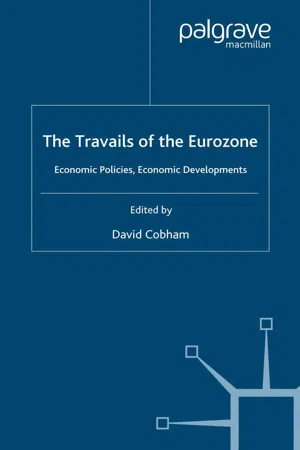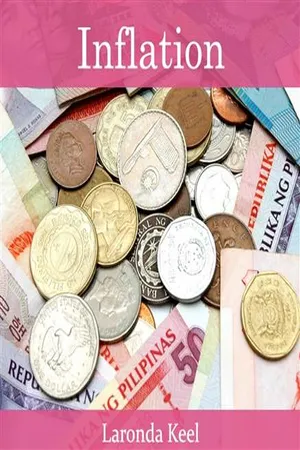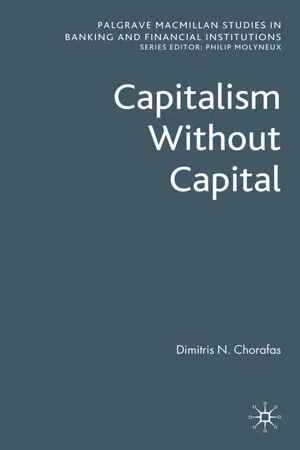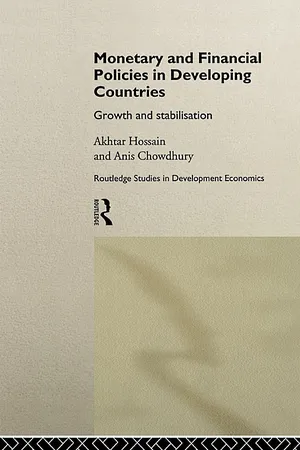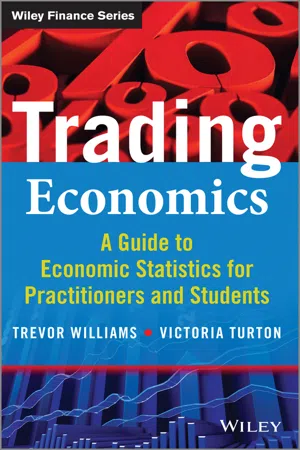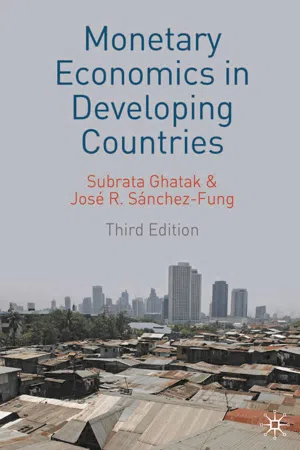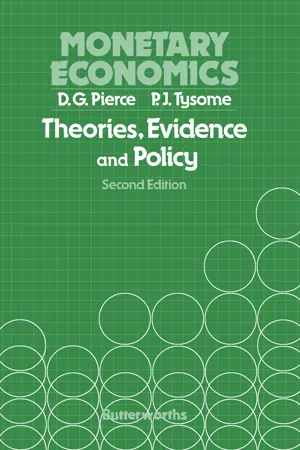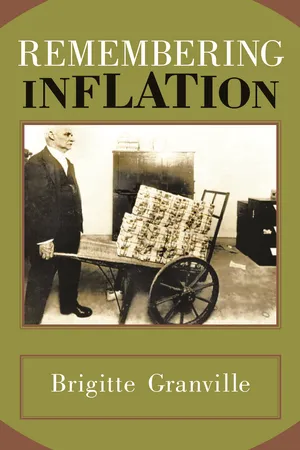Economics
Money Growth and Inflation
Money growth and inflation are closely linked in economics. When the money supply in an economy increases rapidly, it can lead to inflation as more money chases the same amount of goods and services, driving up prices. Central banks often aim to manage money growth to maintain stable inflation rates, as excessive inflation can erode the purchasing power of money.
Written by Perlego with AI-assistance
Related key terms
1 of 5
10 Key excerpts on "Money Growth and Inflation"
- eBook - PDF
Travails of the Eurozone
Economic Policies, Economic Developments
- D. Cobham(Author)
- 2007(Publication Date)
- Palgrave Macmillan(Publisher)
2 Understanding the Link between Money Growth and Inflation in the Euro Area Katrin Assenmacher-Wesche and Stefan Gerlach* Introduction In preparation for the establishment of European Monetary Union in January 1999, the European Central Bank (ECB) decided to adopt a mone- tary policy strategy consisting of two main elements or ‘pillars’. The first of these was ‘a prominent role for money with a reference value for the growth of a monetary aggregate’, subsequently defined to be 4.5 per cent annual growth of M3, and the second ‘a broadly-based assessment of the outlook for future price developments’. 1 From the outset this two-pillar framework was contro- versial. One explanation for this might have been that the ECB provided neither an explicit representation of the inflation process nor a motivation for why it necessitated a two-pillar framework. Whatever the reasons, many observers misinterpreted the two pillars as combining monetary and infla- tion targeting, and criticised the framework for being inconsistent and lacking clarity. Recently several authors have presented empirical models that provide a formal interpretation of the two pillars by incorporating money growth in a reduced-form Phillips-curve model for inflation. The monetary and the economic pillars of the ECB’s framework are in these models viewed as reflecting different time perspectives on the determination of inflation. While money growth impacts on inflation in the long run, real economic indicators such as the output gap and cost-push factors influence inflation in the short run. This notion of different time horizons in the determinants 10 *We are grateful to Michael Sumner (our discussant) and conference partici- pants for helpful comments and to Björn Fischer for data. The views expressed are solely our own and are not necessarily shared by the SNB or the BIS. - No longer available |Learn more
- (Author)
- 2014(Publication Date)
- Orange Apple(Publisher)
____________________ WORLD TECHNOLOGIES ____________________ Chapter- 1 Inflation In economics, inflation is a rise in the general level of prices of goods and services in an economy over a period of time. When the general price level rises, each unit of currency buys fewer goods and services. Consequently, inflation also reflects an erosion in the purchasing power of money – a loss of real value in the internal medium of exchange and unit of account in the economy. A chief measure of price inflation is the inflation rate, the annualized percentage change in a general price index (normally the Consumer Price Index) over time. Inflation's effects on an economy are various and can be simultaneously positive and negative. Negative effects of inflation include a decrease in the real value of money and other monetary items over time, uncertainty over future inflation may discourage investment and savings, and high inflation may lead to shortages of goods if consumers begin hoarding out of concern that prices will increase in the future. Positive effects include ensuring central banks can adjust nominal interest rates (intended to mitigate recessions), and encouraging investment in non-monetary capital projects. Economists generally agree that high rates of inflation and hyperinflation are caused by an excessive growth of the money supply. Views on which factors determine low to moderate rates of inflation are more varied. Low or moderate inflation may be attributed to fluctuations in real demand for goods and services, or changes in available supplies such as during scarcities, as well as to growth in the money supply. However, the consensus view is that a long sustained period of inflation is caused by money supply growing faster than the rate of economic growth. Today, most mainstream economists favor a low steady rate of inflation. - eBook - PDF
- D. Chorafas(Author)
- 2009(Publication Date)
- Palgrave Macmillan(Publisher)
50 Money The second basic principle of sound economic management is that money supply affects the rate of spending. Ideally, we need an MS large enough to give us a gross domestic product that represents nearly full employment at stable prices and to stimulate growth. It never happens that way, because in practice things are not that simple. Adjusted for inflation, money growth has accelerated alarmingly with the result that the entire world’s money supply is growing at its fastest for decades, in real terms. One might expect emerging economies’ money supply to out- pace that of the western world, because their GDP growth is faster. But their surplus money growth over and above the increase in nominal GDP (sec- tion 1) is exporting inflation. Over and above that, China and India have real interest rates (Chapter 4) among the world’s lowest, even though they have the fastest-growing economies. Another powerful reason why money supply has been overshooting targets set by western central banks is that the commercial banks have been lever- aging the financial system. “There is no limit to the amount of money that can be created by the banking system,” Marriner Eccles, the chairman of the Federal Reserve in the Franklin Roosevelt years, warned, “but there are limits to our productive facilities which can be only slowly increased, and which at present are being used at near capacity.” 4 This is particularly true when politi- cians pressure the central bank to keep interest rates low, both to hold down the cost of government borrowing and to encourage private economic activ- ity – leading to a conflict of responsibilities and disabling monetary policy of its role of: • Regulating money and credit, and • Maintaining economic stability. Speedy monetary growth can have disastrous consequences in the medium to longer run. - eBook - ePub
Monetary and Financial Policies in Developing Countries
Growth and Stabilization
- Anis Chowdhury, Akhtar Hossain(Authors)
- 2003(Publication Date)
- Taylor & Francis(Publisher)
0 is the rate of velocity at zero inflation and ω is the coefficient on inflation. Substitution of equation (2.14) into equation (2.12) gives the following relationIt shows that inflation is not a linear function of economic growth. The ratio of inflation to economic growth rises with economic growth, which means that the greater the growth rate financed by money creation, the larger will be the marginal increment of inflation. A limit will eventually be reached at which inflation will approach infinity, such thatIt is the value when the denominator in equation (2.15) is zero. For example, when ω=10 (the case discussed by Mundell), to raise the growth rate by 1 per cent will require an acceleration of inflation by 57 per cent per annum. And the maximum growth rate possible is 1.5 per cent per annum when inflation approaches infinity.Inflationary finance and the danger of hyperinflation
The policy of inflationary finance has been criticised by Bailey (1956), Dornbusch and Reynoso (1989), Mundell (1965, 1971), Marty (1967, 1973), and Friedman (1971). The standard argument against inflationary finance is that it imposes welfare costs on money holders. However, the effective argument against inflationary finance in developing countries is that once a licence to print money is given to the government there is no guarantee that it will stop short of hyperinflation. Economists working on Latin American inflation history would testify that hyperinflation in Latin American countries was ‘triggered by large budgetary deficits and sustained by subsequent ongoing deficits, virtual economic collapse, and steadily rising inflationary experiences’ (Gillis et al., - eBook - PDF
Trading Economics
A Guide to Economic Statistics for Practitioners and Students
- Trevor Williams, Victoria Turton(Authors)
- 2014(Publication Date)
- Wiley(Publisher)
4 Inflation Inflation is always and everywhere a monetary phenomenon in the sense that it is and can be produced only by a more rapid increase in the quantity of money than in output. Milton Friedman 1 WHAT IS INFLATION? Inflation tells us the changing (increasing) price of a range of goods or services; basically how much of something we can get for our money. The rate of change of prices – the speed at which the price of goods and services that are bought by households or businesses alter – is called inflation. But prices can also fall, in a process called deflation, sometimes termed negative inflation. Inflation is more common than deflation, or at least it has been in the last 50 years or so, and so it has become associated with changes in the price of goods and services. Historically, however, price falls were as common as price rises, as we will see later. Both inflation and deflation have advantages and disadvantages, which we will explore in more detail later in this chapter. THE HISTORY OF INFLATION Inflation has been around for a long time, but, as Figure 4.1 shows, the level of prices (the index) really only rose consistently and sharply in the UK from the 1970s onwards. This was after the US came off the gold standards and the Bretton Woods system of fixed exchange rates, which had prevailed after the Second World War, ended. Money was now backed by government fiat and trust rather than by gold. And exchange rates were no longer fixed but allowed to float freely. This seems to have led to a rapid rise in the level of prices or, in other words, to the Retail Prices Index. Before that, for hundreds of years, the level 1 Friedman, M., The Counter-Revolution in Monetary Theory (1970). 100 Trading Economics Retail Price Index (1987 = 100) 0 10 20 30 40 50 60 70 80 90 100 1264 1296 1328 1360 1392 1424 1456 1488 1520 1552 1584 1616 1648 1680 1712 1744 1776 1808 1840 1872 1904 1936 1968 2000 Figure 4.1 Price index over time. - eBook - PDF
- Subrata Ghatak, José R. Sánchez-Fung(Authors)
- 2017(Publication Date)
- Red Globe Press(Publisher)
The overall conclusion that might be suggested is that there are a number of reasons for expecting that inflation much in excess of 10 per cent per annum is likely to have an adverse effect on the long-run development of a country, since any positive impact on total investment can easily be outweighed by adverse effects on the composition of investment, the degree of monetization and the efficiency of the financial system. In the long run, growth and development may best be promoted by having a target rate of inflation of zero, while erring on the side of inflation rather than deflation. 9.3.1 Further empirical evidence on inflation and growth The evidence explained so far in this chapter assumes implicitly that there is a linear relationship between money and growth, and there is somewhat firm evidence that high inflation is bad for growth (see, for example, De Gregorio, 1992; Barro, 1995). However, an influential paper by Levine and Zervos (1993) revealed that inflation’s effect on output does not pass Leamer’s extreme bounds tests in growth regressions (see also Sala-i-Martin, 1997). That is, inflation is not associated robustly with economic growth in a statistical sense. Also, Bruno and Easterly (1998) showed that, after excluding countries with inflation rates above 40 per cent from growth regressions, inflation’s statistical significance diminishes. And other authors, such as Temple (2000), are rather sceptical about the literature examining the link between inflation and growth. Still, ongoing research efforts are making progress in improving our understanding of the critical relationship between inflation and growth. In particular, modelling the relationship among these variables has recently considered the relevance of looking at non-linear and threshold effects. That is, whether or not there is a certain level (threshold) of inflation beyond which it matters more, say, than at lower levels (non-linearity), in determining economic growth. - Berkeley Hill(Author)
- 2013(Publication Date)
- Pergamon(Publisher)
Assuming that the velocity of circulation (V) is constant, as long as the quantity of goods and services (T) which the nation produces increases in step, there is no reason why the general level of prices should change, i.e. no inflation will occur. This can happen if the country has unused produc-tive resources (as happens in a slump) which can be used to boost output. If, however, all the resources are fully employed,** increasing aggregate demand and the money supply cannot be accommodated by changes in T, and P must rise instead, i.e. inflation will result as an increasing quantity of money chases a non-increasing quantity of goods. This is equivalent to the situation referred to back in Fig. 8.7 where an inflationary gap was identified. This type of inflation is termed demand pull because it is caused by excess demand in the economy. There is much dispute over the ability of an expansion in the money supply to cause a rise in demand; some eco-nomists (the monetarists) believe that money has this active property while others (the neo-Keynsians) conclude that a rising money supply simply enables excess demand resulting from the intended level of govern-ment and private spending being greater than the value (at existing prices) of what is available for purchase to be realised in higher prices. Most exponents of either view would agree, however, that a money supply which consistently increases faster than the growth in output of goods and services will be associated with rising prices. Increases in productivity have a role to play in mitigating the infla-tionary effect of a rising money supply as they increase the quantity of * Sometimes y is given in the equation rather than T, y standing directly for the flow of goods and services over the given period. **In the longer term view, if the equilibrium level of unemployment has been reached.- eBook - PDF
Monetary Economics
Theories, Evidence and Policy
- David G. Pierce, Peter J. Tysome(Authors)
- 2014(Publication Date)
- Butterworth-Heinemann(Publisher)
(4) Resistance to cuts in real standards of living caused by higher import prices and deflationary government policies. (5) The extension of wage comparability to inter-country comparisons of relative wages. As we did with the market theories of inflation so we must now consider the role of the money supply in the non-market theories. If prices rise because of upward pressure being exerted on costs, then in order to 'finance' the same volume of real transactions there must either be an increase in the velocity of circulation of money or the money stock must rise. Let us assume for the moment that neither of these possibilities occurs. What will be the result? Clearly there must be a fall in the volume of transactions. Interest rates will rise because the demand for real money balances exceeds the supply, and there will be a fall in interest-sensitive expenditures. If initially there was equilibrium in the goods and labour markets then the fall in demand will result in an excess supply of goods and of labour. If wages are pushed up independently of the state of the goods and labour markets. Inflation in an international context 213 Inflation in an international context Our discussion of inflation has so far implicity been confined to closed economies. The 1970s, however, saw inflation being increasingly considered as an international phenomenon. In this final section we shall therefore extend our analysis to consider the generation and international transmission of inflation in a context of open economies. The various approaches to the analysis of inflation in countries that engage in international transactions can again be classified into market and non-market ones. We shall devote most space to a consideration of the market approaches. Market theories We shall subdivide the market theories into two groups. First of all we shall consider the approach commonly known as global monetarism. - eBook - PDF
Fundamentals of Financial Instruments
An Introduction to Stocks, Bonds, Foreign Exchange, and Derivatives
- Sunil K. Parameswaran(Author)
- 2022(Publication Date)
- Wiley(Publisher)
CHAPTER 13 The Macroeconomics of Financial Markets T he financial markets are a key component of the economy of a country. Thus, it is not surprising that decisions taken by the government of a country and its central bank have major consequences for the working of such markets. Activities in a country’s domestic financial markets are related to activities in foreign markets as well. Thus, decisions taken in one country invariably have implications for the financial markets of other countries. The policies of significance for a country’s financial markets are the fiscal and monetary policies designed and implemented by the federal government and the cen-tral bank, respectively. An economy’s interest rates, which influence all decisions of significance, are determined by such policies. Trade with foreign countries, for-eign investments in the domestic economy, and a country’s investments in foreign economies are also influenced by such policies. ECONOMIC GROWTH Economic growth is a measure of the expansion of an economy over time. It is mea-sured by comparing the output for a period, such as a year or a quarter, with the output of the previous period. Output in an economy is referred to as the gross domestic product or GDP. We will define the GDP shortly, as well as a related measure known as GNP or gross national product . Considering that inflation is a constant feature in life, GDP will increase over time even if the real output remains constant. Consequently, the standard practice is to measure the GDP for a year using the price level of a base year. GROSS DOMESTIC PRODUCT GDP is a measure of the output of a country within its borders. The output could be on account of economic activities carried out by its nationals, or by foreign nationals operating in the country. The output refers to the final output, and intermediate prod-ucts are not counted, for the final output subsumes the same. - eBook - PDF
- Brigitte Granville(Author)
- 2013(Publication Date)
- Princeton University Press(Publisher)
Milton Friedman (1968: 12) observed that “every major inflation has been produced by monetary expansion—mostly to meet the overriding demands of war which has forced the creation of money to C H A P T E R 2 34 supplement explicit taxation.” But the story does not end there. This sec-ond chapter turns to subsequent important developments in economists’ thinking on the origins of inflation. These new ideas, which first emerged in the early 1980s and were elaborated during the following two decades, demonstrated that tighter monetary policy is not a sufficient condition for controlling the rate of inflation. For this purpose of examining the roots of inflation, one-off price in-creases may be ignored. Such increases may be due to an external shock such as an increase in the price of oil or other commodities, and which for a limited period may have an effect on the price index depending on the weight of these commodities in the domestic basket used for the calcula-tion of the percentage change in the price level. An increase in VAT is an example of the several other kinds of shocks that can have a material short- term effect on “inflation” in the sense of the price index. Throughout history since the invention of money, inflation has been an elusive phenomenon. Money improved on barter both by making trading exchanges more efficient and by creating a means of savings. It also allowed exchange and saving to be easily accounted for. These attributes and the utility of money are impaired by inflation, which reduces the quantity of goods or services that can be bought with the same amount of money over a certain period of time. When money was a commodity itself, such as gold, silver, or copper, discovery of new deposits led to inflation. The monetary coinage was often debased to finance spending when taxes proved insuffi-cient to finance wars, monuments, or other projects. Such has been the im-memorial practice of spendthrift rulers and regimes of all kinds and times.
Index pages curate the most relevant extracts from our library of academic textbooks. They’ve been created using an in-house natural language model (NLM), each adding context and meaning to key research topics.
